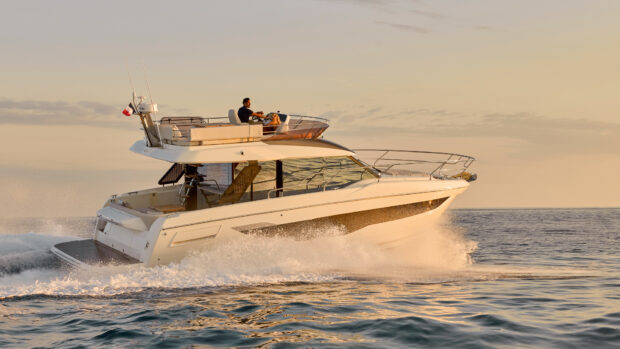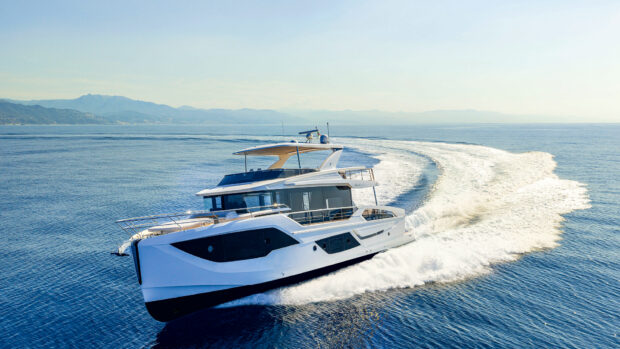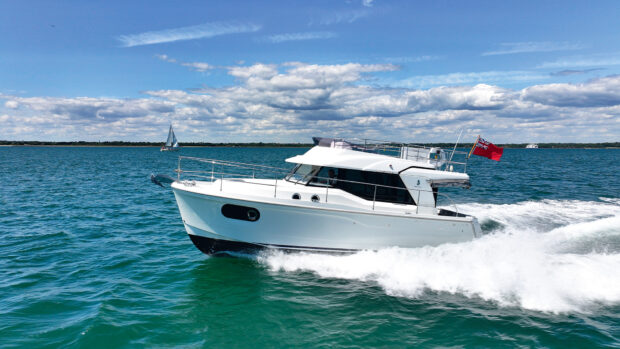A high-performance boat is largely about going fast and looking cool – and the Sunseeker Superhawk 43 isn’t going to let you down in that regard. But can the twin-stepped hull and Arneson surface drives cope with a two-metre chop?
Blasting along through metre-high seas and a blustery Force 4 at 55mph – the speed that Americans deem to be safe on their highways – is a hoot in any small boat.
But, to paraphrase one well-known tyre manufacturer, power without control is nothing, and that’s especially true on a vehicle that does not have the advantage of a flat surface to smooth its high-speed ride.
On Sunseeker’s Superhawk 43, the connection with the water is provided by Arneson surface drives and a twin-stepped hull, both mechanisms that aim to increase speed by cutting drag by reducing the contact with the water.
Given that’s exactly the opposite solution that you find in a powerful car, with its big tyres and downforce-generating aerodynamics, you can be forgiven for thinking that this is hardly the way to maximise boat control.
Driving the Sunseeker Superhawk 43
Let’s skip straight to the good news: the Sunseeker Superhawk 43 is so controllable, so easy and forgiving to drive that you will rarely notice that you’re driving a stepped-hull boat.
With conditions ranging from the choppy Force 3 that we found inside Poole Harbour for our speed trials, to the closely spaced 2m seas that had piled up just beyond Old Harry, finding the chop necessary to ‘free’ a stepped hull boat from the water to maximise its speed was never a problem.
Whatever hooligan handling the Sunseeker Superhawk 43 was subjected to, it never showed a tendency to misbehave.
Turns were smooth and controlled at any speed and at any rate from gentle to full lock, where the 43 could be hauled round far quicker than a shaftdrive boat.
Only once in two hours, travelling flat out with the sea on the quarter then pushing the Sunseeker Superhawk 43 into a sharp turn, did the back end skip sideways, but that was just us catching an awkward wave, not the stepped hull spinning out in any way.
Considering the boat’s beam (at 11ft 11in/3.63m it’s a foot wider than the slender Hunton XRS43), the ride was pretty good.
The Sunseeker Superhawk 43 could be driven flat out on any point in waves up to about a metre high, and flat out downwind in the 2m seas, and I only had to slow upwind through these larger waves.
Not surprisingly, with so much windblown water piling over the screens in these blustery Force 4 conditions I got very wet, my lightweight jacket and chest-high trousers only keeping me dry below the knees!
The Arneson contribution to the experience was easy-going, too.

Deep wraparound seats keep helmsman and crew firmly in place.
You’ll know you’re driving a surface-drive boat – compared with a sterndrive boat, the archetypal lack of low and mid-range accelerative urge found in surface-drive boats is just as obvious on the 43, so throttling up and down through the waves is never going to be as easy.
That said, when we had to slow down in the choppy seas, I didn’t feel the same lack of control as I have on some heavier Arneson-powered boats – the lag is unmistakable but it’s never troublesome.
Arneson drives do respond to correct trimming, but those on the Sunseeker Superhawk 43 were remarkably forgiving. Too far out and you can hear the props over-rev, so correction is easy.
Trim too far in and you will reduce your speed but the 43 never complains or becomes wayward.
There is an enduring rumour that Arneson boats are very difficult to handle around the marina.
It’s true that they handle differently, but think ‘sterndrive with reduced stern thrust’ and you’ll be fine.
Our boat seemed to respond to a slightly different manoeuvring technique.
It paid to use full lock on the wheel and control the turn with the throttles, rather then controlling the tightness of the turn with the wheel as you might on a sterndrive boat.
If this were my boat, I’d be tempted to ask Sunseeker for a more powerful bow thruster.
Their optional 4hp Lewmar should be fine in theory but, despite the 43’s low profile, its long snout tended to blow around more enthusiastically than I expected in the Force 3 winds we had in the marina.

Black finish on dash gets hot in the sun but helps to kill glare and reflections.
Another essential control element is the link between the boat and the helmsman.
With their padded bases folded down, the seats became semi-circular tubes that held us firmly in place.
Everything is fixed, but the wheel-throttle-seat arrangement works okay.
Trim-tab gauges would be a welcome addition, and placing the Arneson trim buttons either side of the tabs is an impractical nod to stylistic symmetry.
Still, five minutes with a screwdriver would fix that, making them far easier to operate. In general though, the Sunseeker Superhawk 43 will accommodate most shapes and sizes of helmsmen reasonably well.
Only one thing blights the otherwise hugely enjoyable driving experience – the view out. This is a constant bugbear of mine, but in my opinion, tinted forward screens like those on the 43 should be outlawed.
In gloomy conditions like we had on test, they severely impinge on a safe view out and, in my experience, they don’t even work well in bright conditions compared with a good pair of polarised sunglasses.
Sunseeker have exacerbated the problem by leaving the port-side wiper off – imagine having to pay extra for a passenger-side wiper on your car!
Lastly, fellow sub-5ft-7in-tall drivers might like to organise some form of folding foot-rest so that they have the option of elevating their head above the top of the screens for those wind-in-the-hair moments.
Speed
One of the appealing things about this Sunseeker Superhawk 43 is the varied choice of engines and drive systems.
The cheapest is the £305,000 Volvo D6-350hp sterndrive option, which Sunseeker estimate will achieve 43 knots.
Next comes their £345,450 triple with three 315hp Yamaha sterndrives – Sunseeker claim this is a 46-47-knot boat.

Once the removable glassfibre trays are lifted out, engine access from above is good.
Ours was the most powerful option with its smooth 480hp Yanmar diesels coupled to the beautifully engineered Arneson surface drives, which achieved an average 47.6 knots (54.8mph) over a two-way run.
Interestingly, this speed puts it head to head with an equally glamorous 43ft sportscruiser from another renowned British builder, Hunton Powerboats.
Hunton’s XRS43 (tested MBY August 2003 as the Gazelle) is just as well built, engineered and finished as the Sunseeker Superhawk 43.
With its slender hull being a foot narrower than Sunseeker’s 43, it’s less roomy down below and in the cockpit but, not surprisingly, its narrow deep-vee hull ultimately produces a smoother ride in really rough conditions.
Perhaps the most interesting difference to ponder, though, is the price-speed relationship. Where the more voluminous Superhawk 43 needs 480hp Yanmars and Arnesons to achieve its 47.6 knots, Hunton’s slimmer XRS43 should achieve this speed with a pair of Volvo’s new D6-370 DPR sterndrives.
Not surprisingly, with the expense of the Arnesons and the bigger Yanmars to carry, the surface-driven Sunseeker Superhawk 43 starts at £410,000, whereas the XRS43 kicks off just above £250,000.
Above & below decks
On deck, versatility is the watchword. The folding cockpit table can be made to disappear quickly behind the seats, and the back-rests on the athwartships seats can be hinged forwards or backwards or made to lie flat, depending on how the seats and sunbeds are being used.
Likewise, the front end of the central walkway hinges to become a seat.
The storage under the seats is easy to get to, plus the sunbed bases lift on gas struts to reveal a pair of large removable trays, adding considerably to the usable stowage.
Along with the separate deck hatch further forward, these moulded trays also make the machinery access first rate.
There is an amusing warning at the base of the radar arch that reads: ‘No passengers on side deck’. It’s not as health-and-safety-gone-mad as it sounds.

Unexpectedly good galley for a pocket rocket.
With its low guardrails demanding a crouch, and its slender side decks further narrowed by the stylistic bulges at the base of the radar arch, moving forward safely demands considerable concentration.
Down below, the surprise is the unexpectedly good galley.
Okay, it’s no gourmet’s nirvana, but it’s not much smaller than many of the galleys on conventional 43ft sportscruisers, which is pretty good for a pocket-rocket like the Sunseeker Superhawk 43.
Thanks to its great width, the forward berth looks short – in fact, it’s 6ft 2in (1.88m) long, with the two settee berths a couple of inches longer.

Port-side settee back-rest can be hinged up to form a single berth, leaving another single beneath.
Headroom is 5ft 11in (1.80m) at the foot of the steps, dropping 2in at the front of the cabin.
Sure, its low profile means that it’s unavoidably compact, but the Sunseeker Superhawk 43 is not a boat that feels cramped or squeezed down below.
Sunseeker Superhawk 43 verdict
It’s stylish, it’s sturdily built and well engineered, and with the exception of the narrow side decks and the tinted screens, for a 44ft 3in-long (13.49m) pocket rocket whose focus is surely going fast and looking cool, the Superhawk 43 fares well on the practical front.
Best of all, though, is that this speed does not come with the baggage of tiresome handling.
As 55mph stepped-hull Arneson-drive sportscruisers go, it’s remarkably docile and easy to handle, letting you get the best out of the boat with little effort.
First published in the October 2007 issue of MBY.
Pros
- So easy to drive
- Versatile seating & sunbed design
- Accessible cockpit stowage
- Easy machinery access
- Versatile folding cockpit table
- Choice of engines and drive systems
- Unexpectedly good galley
Cons
- Tinted screens
- Precarious side deck transit
- Only one windscreen wiper
Details
Price from: £305,000 inc UK VAT (twin 350hp sterndrive)
Price from: £410,000 inc UK VAT (twin 480hp Arneson surface drive)
Overall length: 44ft 3in (13.49m)
Waterline length: 32ft 8in (9.97m)
Beam: 11ft 11in (3.63m)
Displacement: 8.5 tonnes half load (100% fuel & water = 1.0 tonne)
Draught: 3ft 6in (1.08m)
Air draught: 8ft 6in (2.60m)
Fuel capacity: 220 imp gal (1,000 litres)
Water capacity: 44 imp gal (200 litres)
Flat out: 47.6 knots (54.8mph) 36.1gph, 1.32mpg, 232 miles @ 3,400rpm
Test engines: Twin Yanmar 6LY3A 480hp @ 3,300rpm 6-cylinder 5.813-litre diesels Arneson surface drives
RCD category: B (for 8 people)
Designer: Sunseeker & Don Shead, 2006
Contact: Sunseeker Sales Group
Tel: +44 (0)1202 666060
Website: www.sunseekersalesgroup.com
Sunseeker London: Tel: +44 (0)20 7493 3441
Website: www.sunseekerboats.co.uk









